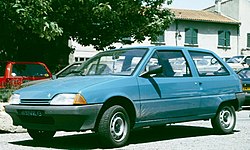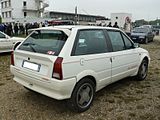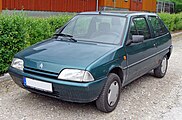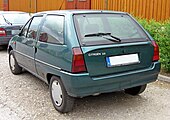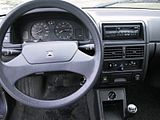Citroën AX
| Citroën | |
|---|---|
|
Citroën AX three-door (1986-1991)
|
|
| AX | |
| Production period: | 1986-1998 |
| Class : | Small car |
| Body versions : | Station wagon |
| Engines: |
Otto engines : 1.0–1.4 liters (33–72 kW) Diesel engines : 1.4–1.5 liters (37–40 kW) Electric drive : 11-20 kW direct current shunt motor |
| Length: | 3490 mm |
| Width: | 1560 mm |
| Height: | 1350 mm |
| Wheelbase : | 2285 mm |
| Empty weight : | 640-840 kg |
| Previous model |
Citroën LN Citroën Visa |
| successor | Citroën Saxo |
The Citroën AX is a subcompact model from the French automaker Citroën . It was built from mid-1986 to the end of 1998 at the Aulnay-sous-Bois plant , northeast of Paris.
positioning
The AX succeeded the Citroën Visa and the Citroën LN and was intended to close the gap that had opened in the 1980s between the mid-range Citroën BX on the one hand and the now outdated Citroën 2CV on the other.
Development and model history
The primary goal in the development of the AX was to put a small car with the largest possible interior space and the lowest possible weight on its wheels. Findings from the ECO 2000 project served as a model , on the basis of which the development of the first prototype with the name S9 began in 1981. The designer Nuccio Bertone contributed to the design and contributed several designs.
The low weight , the entry-level AX 10 E weighed only 640 kg, was due to the consistent use of lightweight materials, for example the lower part of the tailgate was made of plastic.
As with other Citroëns, the body was streamlined. The drag coefficient (C w ) of 0.31 in 1986 was unusually low for this vehicle class.
A high level of rust resistance was achieved through the use of galvanized sheet metal, plastic wheel housing and cavity sealing.
The Citroën AX was presented at the Paris Motor Show in the spring of 1986. From September of the same year it was sold in France, while the market launch on the German market took place in March 1987.
The first series featured a large number of shelves and storage options throughout the interior. The front doors of the three-door models even had holders in which there was space for the French 1.5-liter mineral water bottles.
At the beginning of 1988, the AX, which had previously only been available with three doors, was supplemented by a five-door variant. The bottle cages gave way to the speakers in this version.
In motorsport, success was achieved with this model, especially with the high-performance Sport and GTi versions .
The AX was also offered with a diesel engine . For years, this variant was the most economical mass-produced vehicle in the world.
Facelift
In July 1991, some model maintenance measures were carried out on the AX . The most noticeable differences on the outside were white turn signal glasses at the front, a modified tailgate and the branding now placed in the middle of the bonnet. The changes in the interior were more extensive. The dashboard, described by many critics as “jagged”, has been smoothed out considerably, and some of the “small items” have been omitted.
According to the sales brochure from Citroën, the 1.4 l diesel from 1992 had a consumption of 3.2 liters / 100 km at 90 km / h, but with special low-friction tires from Michelin.
In 1994 the AX Eco set the fuel consumption record of 2.7 l / 100 km. The Eco was a modified test vehicle based on the diesel model. The car, which weighs only 672 kg, also received a long-geared transmission and modifications to the injection system. In addition, lightweight plastic body parts and aerodynamic panels were used. The tires had particularly low rolling resistance.
Production in France ended in December 1998 after 2,424,808 units of different variants and special models had left the factory. The successor is the Citroën Saxo . In Malaysia the AX was produced under license as the Proton Tiara for the Asian market until 2000 .
The “TU” engine was derived from the “X” engine introduced in the Peugeot 104 and also used in the 205 . It was no longer leaning back as much as the X, and the gearbox was next to it, not below it. The chassis was provided with MacPherson struts at the front and parallel swing arms and torsion bars at the rear. The drive block, floor pan and chassis of the Citroën AX can also be found in the Peugeot 106 from 1991.
Engines
The new generation of the PSA-TU engine was specially introduced for the Citroën AX, and it has proven to be very robust and easy to maintain. The water-cooled four-cylinder in-line engine of the AX is installed transversely . The carburetors of the engines of the first series were later replaced by modern injection systems with regulated catalytic converters.
| liter |
Cubic capacity cm³ |
Engine type | Construction year | Carburetor | power | Torque |
| 1.0 | 954 | TU9 (C3A) | from 9/1986 | Solex 32 PBISA 16 | 33 kW (45 PS) at 5200 rpm | 71 Nm at 2800 rpm |
| 1.1 | 1124 | TU1 / K (H1B) | from 9/1986 | Solex 32 PBISA 16 | 40 kW (54 PS) at 5800 rpm | 89 Nm at 3200 rpm |
| 1.4 | 1360 | TU3 (K1B) | from 9/1986 | Weber 34 TLP 8 | 48 kW (65 PS) at 5200 rpm | 109 Nm at 3000 rpm |
| 1.4 | 1360 | TU3CP (K1F) | from 7/1988 | Weber 34 TLP 14 | 51 kW (69 PS) at 5400 rpm | 107 Nm at 3200 rpm |
| 1.0 | 954 | TU9K (C1A) | from 7/1991 | 33 kW (45 PS) at 5200 rpm | 70 Nm at 3200 rpm | |
| 1.1 | 1124 | TU1CP (HAZ) | from 9/1987 | Solex 34 TBIA | 40 kW (54 PS) at 5800 rpm | 88 Nm at 3200 rpm |
| 1.4 | 1360 | TU3CP (KAY) | from 5/1987 | Solex 34 TBIA | 44 kW (60 PS) at 6000 rpm | |
| 1.4 | 1360 | TU32K (K2D) | from 7/1991 | 55 kW (75 PS) at 5800 rpm | 114 Nm at 3800 rpm | |
| 1.3 | 1294 | TU24 | from 9/1986 | Solex double carburetor | 70 kW (95 PS) at 6800 rpm | 113 Nm at 5000 rpm |
| liter |
Cubic capacity cm³ |
Engine type | Construction year | injection | power | Torque |
| 1.0 | 954 | TU9MZ (CDY) | from 7/1992 | Bosch Mono-Motronic | 33 kW (45 PS) at 6000 rpm | 74 Nm at 3600 rpm |
| 1.1 | 1124 | TU1M / 2 (HDZ) | from 7/1989 | Bosch Mono-Jetronic | 44 kW (60 PS) at 6200 rpm | 88 Nm at 3800 rpm |
| 1.1 | 1124 | TU1MZ (HDZ) | from 7/1992 | Magneti-Marelli monopoint | 44 kW (60 PS) at 6200 rpm | 88 Nm at 3800 rpm |
| 1.4 | 1360 | TU3M (KDZ) | from 7/1988 | Bosch Mono-Jetronic | 55 kW (75 PS) at 6200 rpm | 109 Nm at 4000 rpm |
| 1.4 | 1360 | TU3MZ (KDY) | from 7/1991 | Bosch Mono-Jetronic | 55 kW (75 PS) at 6200 rpm | 109 Nm at 4000 rpm |
| 1.4 | 1360 | TU3MCZ (KDX) | from 1/1993 | Bosch Mono-Motronic | 55 kW (75 PS) at 5800 rpm | 111 Nm at 3400 rpm |
| 1.4 | 1360 | TU3FJ2L (motor vehicle) | from 7/1991 | Bosch Motronic MP3.1 | 69 kW (94 PS) at 6600 rpm | 117 Nm at 4200 rpm |
| 1.4 | 1360 | TU3FJ2K (K6B) | from 7/1991 | Bosch Motronic MP3.1 | 74 kW (101 hp) at 6800 rpm | 120 Nm at 4200 rpm |
| diesel | ||||||
| 1.4 | 1360 | TU3D (K9A) | from 2/1989 | Lucas - (Roto Diesel) and Bosch injection | 39 kW (53 PS) at 5000 rpm | 86 Nm at 2500 rpm |
| 1.4 | 1360 | TUD3 / Y (K9Y) | from 3/1992 | Lucas (Roto Diesel) injection | 37 kW (50 PS) at 5000 rpm | 82 Nm at 2500 rpm |
| 1.5 | 1527 | TUD5 / Y / L3 (VJY) | from 10/1994 | Lucas (Roto Diesel) injection | 40 kW (54 PS) at 5000 rpm | 95 Nm at 2250 rpm |
Model development, consumption and weights
| model | Cubic capacity cm³ | power | transmission | Doors | Weight | Consumption in l / 100 km | |||
| at 90 km / h | at 120 km / h | urban | total | ||||||
|---|---|---|---|---|---|---|---|---|---|
| AX 10 | 954 | 32.5 kW (44 PS) | 4-speed | 3 | 640 kg | 3.9 | 5.6 | 5.6 | 5.0 |
| AX 11 | 1124 | 40 kW (60 hp) | 4-speed | 3 | 645 kg | 3.9 | 5.6 | 5.7 | 5.0 |
| AX 14 | 1360 | 47 kW (64 PS) | 5-speed | 3 | 695 kg | 4.2 | 6.0 | 6.9 | 5.7 |
| AX Sport | 1294 | 70 kW (95 PS) | 5-speed | 3 | 715 kg | 5.7 | 7.7 | 9.7 | 7.7 |
Special models 1987: En Vogue, Hit FM
| model | Cubic capacity cm³ | power | transmission | Doors | Weight | Consumption in l / 100 km | |||
| at 90 km / h | at 120 km / h | urban | total | ||||||
|---|---|---|---|---|---|---|---|---|---|
|
AX 10 E |
954 | 33 kW (45 PS) | 4-speed | 3-5 | 640-655 kg | 3.9 | 5.6 | 5.6 | 5.0 |
|
AX 11 RE |
1124 | 40 kW (54 PS) | 4/5 speed | 3/5 | 645-660 kg | 3.9 | 5.6 | 5.7 | 5.0 |
|
AX 14 TRS |
1360 | 47 kW (64 PS) | 5-speed | 3/5
5 |
695-710 kg | 4.2 | 6.0 | 6.9 | 5.7 |
| AX GT | 1360 | 62 kW (84 PS) | 5-speed | 3 | 720 kg | 4.9 | 6.6 | 7.6 | 6.4 |
| AX 10 E Entreprise | 954 | 33 kW (45 PS) | 4-speed | 3 | 640 kg | 3.9 | 5.6 | 5.6 | 5.0 |
| AX 11 RE Entreprise | 1124 | 40 kW (54 PS) | 4/5 speed | 3 | 645 kg | 3.9 | 5.6 | 5.7 | 5.0 |
| AX Sport | 1294 | 69 kW (94 PS) | 5-speed | 3 | 735 kg | 5.7 | 7.7 | 9.7 | 7.7 |
The models called "Entreprise" were the entry-level versions of the AX with minimal equipment and low engines that were only sold in France. These models were produced exclusively with carburetor technology and were sold until 1993, when the new injection versions with regulated catalytic converters had long been available. There was also a 4 × 4 variant.
Special models from 1988 : Air France Madame, K.Way, Olympique, Tonic, Volcane, Image, Spot, Opera de Paris
| model | Cubic capacity cm³ | power | transmission | Doors | Weight | Consumption in l / 100 km | |||
| at 90 km / h | at 120 km / h | urban | total | ||||||
|---|---|---|---|---|---|---|---|---|---|
|
AX 10 |
954 | 33 kW (45 PS) | 4-speed | 3-5 | 655/684 kg | 3.9 | 5.6 | 5.6 | 5.0 |
|
AX 11 |
1124 | 40 kW (54 PS) | 4/5 speed | 3/5 | 675/690 kg | 3.9 | 5.6 | 5.7 | 5.0 |
|
AX 14 |
1360 | 55 kW (75 PS) | 5-speed | 3/5
5 |
720/755 kg | 4.2 | 6.0 | 6.9 | 5.7 |
| AX GT | 1360 | 62 kW (84 PS) | 5-speed | 3/5 | from 720 kg | 4.9 | 6.6 | 7.6 | 6.4 |
| AX GTi | 1360 | 69 kW (94 PS) | 5-speed | 3 | 745/795 kg | 5.3 | 6.5 | 8.3 | 6.7 |
| AX 4 × 4 | 1124/1360 | 40/55 kW (54/75 hp) | 5-speed | 3/5 | 750/825 kg | 5.6 | 7.3 | 8.1 | 6.2 |
| model | Cubic capacity cm³ | power | transmission | Doors | Weight | Consumption in l / 100 km | |||
| at 90 km / h | at 120 km / h | urban | total | ||||||
|---|---|---|---|---|---|---|---|---|---|
|
AX 1.0i |
954 | 33 kW (45 PS) | 4/5 gear | 3-5 | 690/706 kg | 4.5 / 4.6 | 6.3 / 6.4 | 6.5 / 6.7 | 5.8 / 5.9 |
|
AX 1.1i |
1124 | 44 kW (60 hp) | 4/5 speed | 3/5 | 691/708 kg | 4.5 | 6.1 | 6.9 | 5.8 |
|
AX 1.4i |
1360 | 55 kW (75 PS) | 5-speed | 3/5 | 772/790 kg | 5.0 | 6.7 | 7.7 | 6.5 |
AX Exclusive Furio |
1360 | 55 kW (75 PS) | 5-speed | 3 | 772 kg | 5.1 | 6.9 | 8.0 | 6.7 |
| AX GT | 1360 | 55 kW (75 PS) | 5-speed | 3/5 | 772/790 kg | 4.9 | 6.8 | 8.0 | 6.6 |
| AX GTi | 1360 | 69 kW (94 PS) | 5-speed | 3 | 795 kg | 5.7 | 7.1 | 8.9 | 7.2 |
| AX 4x4 | 1360 | 55 kW (75 PS) | 5-speed | 3/5 | 820-840 kg | 6.1 | 7.7 | 7.5 | 7.1 |
AX Diesel
The first AX Diesel came on the market in February 1989 with the newly developed four-cylinder aluminum TUD diesel engine, which delivered 39 kW (53 hp) with a 1.4 liter displacement. The two-part crankcase with the crankshaft bearings, the crankshaft , the bearing shells, the oil and water pumps are identical to those of the gasoline engine. The average consumption was 4.6 l / 100 km. He didn't have a catalyst . That changed with the low-pollutant diesel, which was delivered from March 1992 and which, with a modified cylinder head, oxidation catalytic converter and a longer gearbox, achieved a lower consumption of 4.2 l / 100 km. In September 1994 the AX Diesel received a new engine, which now developed an output of 40 kW (54 PS) with a 1.5 liter displacement. Consumption increased slightly to a still economical 4.5 l / 100 km. Due to the high vehicle taxes for the model, the AX Diesel did not attract a large group of buyers.
AX Sport / GT / GTi
AX Sport appeared in France in April 1987, and arrived in Germany with a delay of about half a year. It had a 1294 cc engine with twin carburetors that made 70 kW (95 hp). However, it was only manufactured until December 1988.
From January 1988 the AX GT was produced parallel to the sport . The engine of the GT was 62 kW (84 PS) and, as was still common at the time, was without a catalytic converter. It was only when the AX was revised in summer 1991 that Citroën offered the AX GT with a catalytic converter, which then only had 55 kW (75 HP) with a displacement of 1360 cm³.
In the summer of 1991, the AX GTi appeared with a multipoint injection system (BOSCH Motronic MP 3.1) instead of a carburetor. Lambda control of the exhaust gas behavior was now possible, which also allowed the use of regulated catalytic converters. In the vehicles for the German market, the peak output was 69 kW (94 PS) at 6600 rpm, the max. A torque of 117 Nm was achieved at 4200 rpm. The top speed is 7200 rpm and the compression ratio has been increased slightly to 9.6: 1 compared to the 75 hp engine.
In other countries, the GTi was delivered with a compression ratio of 9.9: 1 and 72 kW (98 hp) at 6800 rpm and without a catalytic converter. At the end of 1996 its production was stopped.
The Citroën AX in the Sport and GTi versions was and is still widely used in motorsport. In the rallycross sector, the 1.4 l displacement vehicle is an affordable entry-level model with which even young people from the age of 16 and without a driver's license can gain real racing experience. The combination of low weight, compactness and high performance was ideal for rallycross.
Sven Seeliger , Germany's only European Rallycross Champion to date, won his titles with a Citroën AX GTi . Banned from the European Championship, the homologation was later extended for the national series. In Sweden and Denmark, too, the vehicle is often used in youth development, where it has its own class, which is referred to as Division 5 in rallycross in Germany.
In the third round of the international German Rallycross Championship in 2006, which was held in Nysum, Denmark, eight Citroën AXs made it to the final, with the brothers Clemens and Julian Meyer claiming the double victory.
AX 4 × 4
In August 1991 the AX range was supplemented by the all-wheel-drive AX 4 × 4. It was offered as a three-door and five-door model and with the 55 kW (75 PS) 1360 cm³ unit from the AX GT.
From the outside, this model can be recognized by its strong plastic ram protection strips and a floor clearance that has been increased by 25 mm .
The rear-wheel drive was activated pneumatically by a switch on the dashboard.
The five-door version of the well-equipped AX 4 × 4, with an empty weight of 840 kg, was the heaviest of all large-series AX.
Special models
- AX Air France Madame : paintwork in black, chrome-plated radiator grille, decorative strips, sports steering wheel
- Formula AX : Edition 600, white paint, decorative stripes, sports steering wheel, black jersey upholstery
- AX Image : decorative stripes, metallic paintwork and special seat covers
- AX K-Way : Logo, decor and seat covers in the style of the fashion brand of the same name
- AX Noir : metallic paint in black, chrome-plated protective strips and decorative strips
- AX Plaisir : paintwork red or white, panoramic roof, sports steering wheel and decorative stripes
- AX Salsa : metallic paint in black, chrome-plated protective strips and decorative strips
- AX Spot : paintwork in red, decorative stripes
- AX Teen (1st series): paintwork in white, blue or red, decorative stripes, jersey seat covers
- AX Teen (2nd series): paintwork in white, black, red or gray, hubcaps, decorative stripes, jersey seat covers
- AX Teen Tonic : metallic paintwork in blue, green or purple, decorative stripes, jersey seat covers
- AX Triade : Edition 900, paintwork in blue, panoramic roof, decorative stripes and jersey-blue seat covers
- AX Volcane : metallic paintwork in dark gray, decorative stripes , partial leather covers
AX Electrique
The AX Electrique , launched in small series in 1993, was the first series Citroën with an electric drive . The electric car had a purely electric drive, a 11- kW - direct current shunt motor that allowed a top speed of 91 km / h. Its range was realistically 100 km. The batteries with a voltage of 120 volts and a charging capacity of 100 Ah were distributed in the engine compartment and in the underbody, which meant that the interior was retained. The energy consumption is around 13-18 kWh per 100 km. Due to the increase in weight - the curb weight was 995 kg compared to the conventionally powered models - the Electrique was only approved for four people.
With the replacement of the AX series by the Citroën Saxo , the AX Electrique was also discontinued at the end of 1996 and replaced by the Saxo electrique .
Of the two types, AX Electrique (395 units) and Saxo Electrique (approx. 2400 units), only around 2800 vehicles were built and only small numbers were exported to Germany, including for the vehicle fleet of the HEW (Hamburger Elektrizitätswerke). With the NiCd batteries from Saft , they are very robust in use when properly cared for, and battery lives of over 120,000 km have been achieved.
In 2008, the Friedrich-Alexander-Universität Erlangen-Nürnberg was involved in the TechFak EcoCar project with converting an AX to an electric car.
literature
- Dieter Korp: Now I'm helping myself. Volume 171: Citroën AX. Motorbuch Verlag, 1994, ISBN 3-613-01617-6 .
- Revue Technique - automobile Citroën AX jusqu'a fin de fabrication moteurs essence. 2003, ISBN 2-7268-4785-4 .
- Subject: New AC GTI vehicle . Citroen Technical Information No. 24, August 5, 1991
- From stingy to oil prince . In: Berliner Zeitung , July 4, 1995
- There is little demand for economical cars . In: Berliner Zeitung , August 29, 1995
Web links
- History of the Citroën AX (French)
- AX prototypes
- 25 years of Citroen AX - article on Focus Online
Individual evidence
- ↑ https://amicale-citroen.de/2013/20-jahre-citroen-ax-electrique/
- ↑ Citroen workshop manual "Technical data PKW 92 - CAR 000920"
- ↑ https://www.ks-auxilia.de/automobilclub/ks-energie-und-umweltpreis/die-preistraeger/preistraeger-1989/ accessed on October 4, 2019.
- ↑ solarmobil.net (PDF; 695 kB) p. 3
